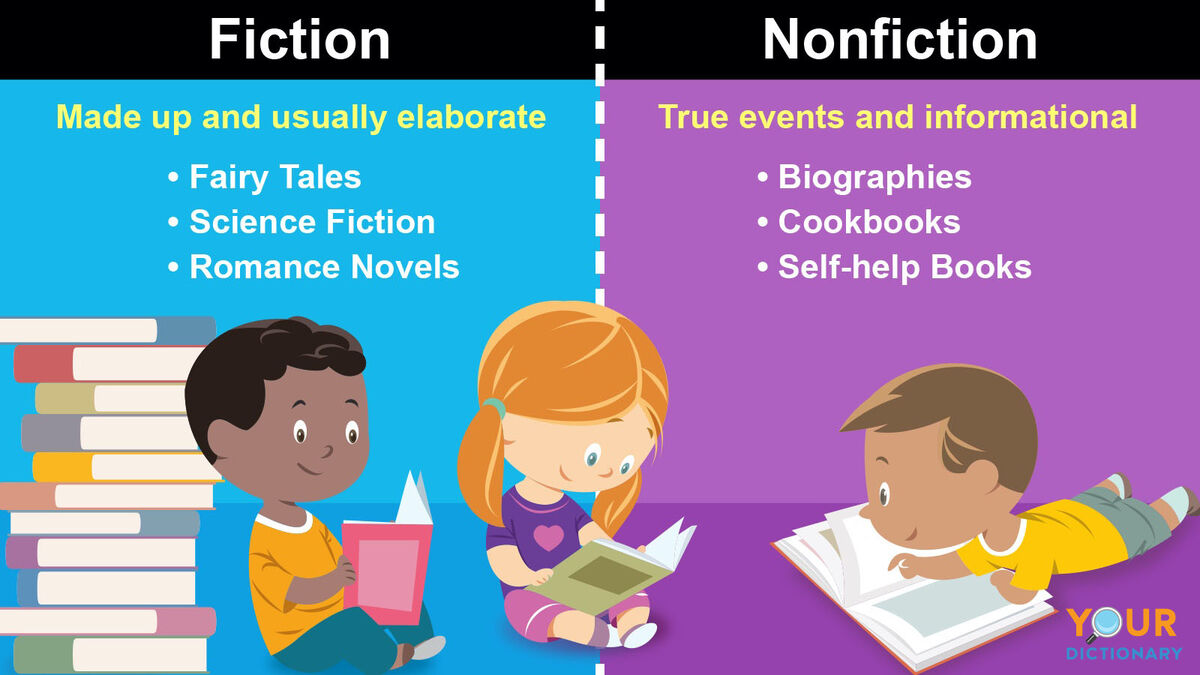
Fiction and nonfiction sound similar, but they mean very different things in writing. Most people have heard that fiction is fake and nonfiction is true. Explore each type of writing to discover all the ways you can tell them apart.
What Is Fiction?
Fiction in writing and literature is defined as “something that is not true.” Most of the information presented in fiction stories and books is made up in the author’s imagination.
An easy way to remember this is with alliteration in the phrase “fiction is fabricated.” While fiction can contain elements that are true or real, like a real town, the majority of the work needs to be made up.
Examples of Fiction Writing
Fiction genres include myths, crime thrillers, fairy tales, science fiction, dystopia, and romance novels. Famous examples of fiction books include:
- Charlie and the Chocolate Factory: Mr. Wonka’s factory isn’t real, even though there are some cool candy factories around the world.
- Frankenstein: Real scientists do create some weird things, but a monster like Frankenstein isn’t one of them.
- Harry Potter series: There is no verifiable wizard community hiding behind magical walls.
- Moby Dick: The book was inspired by a true event, but the story and characters are totally made up.
- Where the Wild Things Are: Max and his mom could be real people, but Max’s trip is not factual.
What Is Nonfiction?
Nonfiction in writing and literature is defined as “a story that is based on true events and information.” All of the information in a work of nonfiction should be verifiable if possible.
An easy way to remember this is with alliteration in the phrase “nonfiction is newsworthy.” Anything presented in the news is supposed to be as factual as possible.
Examples of Nonfiction Writing
Nonfiction genres include biographies, cookbooks, travel guides, history books, and self-help books.
- Dr. Seuss’s ABC: Although the book includes wacky words, it presents the actual English alphabet and words that truly start with each letter.
- I Know Why the Caged Bird Sings: This is an autobiography written by author Maya Angelou about her actual life.
- Mastering the Art of French Cooking: This cookbook presents real French cooking techniques and recipes.
- Miriam Webster Children’s Dictionary: An educational dictionary presents real words and their accepted definitions.
- What Color is Your Parachute?: This self-help book and job-hunting guide is updated every year to share real job market information and job search tips.
What Is Creative Nonfiction?
When a nonfiction book uses a lot of imagination to present the facts, it’s called creative nonfiction. Events are shared as they actually happened, but creative elements are used in the way the story is told.
Examples of Creative Nonfiction Writing
Examples of creative nonfiction genres include memoir and narrative journalism.
- Dandelion Wine: Ray Bradbury’s semi-autobiographical novel takes real childhood memories and turns them into an imaginative story steeped in truth.
- Into the Wild: Author John Krakauer wrote the book based on a few years in the life of a man who abandoned the world to live off the grid using creative license to share the story.
- Hidden Figures (picture book): The true story of how a few Black women impacted the space program is shared in a kid-friendly way that reads more like a story than a biography.
Main Differences Between Fiction and Nonfiction
Aside from fiction being fabricated and nonfiction being factual, these two types of writing have a few other differences.
- The number of facts presented in a work of nonfiction directly impacts its credibility, but facts in a work of fiction don’t change the genre.
- Fiction is usually more elaborate than nonfiction.
- Nonfiction writing needs references, even just a sworn firsthand account.
- Fiction is meant to tell a story mostly for entertainment while nonfiction is meant to share something believed to be true.
Similarities Between Fiction and Nonfiction
Nonfiction and fiction writing have many similarities in their structures and elements. They can both contain characters, a setting, and a plot. Both types of writing can contain elements of truth or real people, places, and events.
Fact or Fiction?
Today, the line between fiction and nonfiction is much thinner than it was historically. Nonfiction writers try to make their information more interesting by using creativity in how they write the truth. Discover all the book genres available by reading some nonfiction books for kids and some classic fiction books.